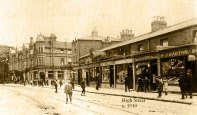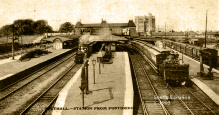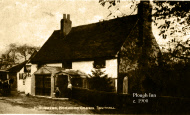1930-1940
For Parliamentary Representation we are still included in the Uxbridge Constituency.
Our MP until 1935 - Lt Col. J. T. Moore Brabazon (Con.); and until 1945 Col. J. J.
Llewellyn (Con.). Population 1930 - 38,500. 1940 - 53,000.
Chairman of The Council
1930-31 Mr W. J. Spencer
1931-32 Mr J. A. Saxon
1932-33 Mr J. A. Saxon
1933-34 Mr C. F. Collins
1934-35 Major A. T. White
1935-36 Mr W. Garrod (Charter Mayor)
1936-37 Mr F. B. Hamblin
1937-38 Alderman G. Pargiter
1939-40 Alderman G. Pargiter
Clerk to the Council till 1935 Mr Staley Brooks. Surveyor, Mr J. B. Thomson and Medical
Officer of Health, Dr Smithard.
 In the early 1930s Southall, like all industrial centres, was hard hit by the recession.
Despite the fact that there was road and house building on a large scale there was
not enough work. There were large queues at the Labour Exchange in the King Street.
This was made worse by workmen from the west of England and Wales coming into Southall
in search of work. The Council started several jobs to create employment. The widening
of Norwood Road which meant the filling in of the Norwood Green Pond in 1930; the
making of an artificial lake and the re-siting of the bandstand in 1932; the conveniences
at the Town Hall and the purchase of two houses in Shackleton Road to allow Lady
Margaret Road to go through to Greenford.
In the early 1930s Southall, like all industrial centres, was hard hit by the recession.
Despite the fact that there was road and house building on a large scale there was
not enough work. There were large queues at the Labour Exchange in the King Street.
This was made worse by workmen from the west of England and Wales coming into Southall
in search of work. The Council started several jobs to create employment. The widening
of Norwood Road which meant the filling in of the Norwood Green Pond in 1930; the
making of an artificial lake and the re-siting of the bandstand in 1932; the conveniences
at the Town Hall and the purchase of two houses in Shackleton Road to allow Lady
Margaret Road to go through to Greenford.
Several people who had served the town well for a great number of years passed on
- Revd Frank Roberts, Vicar of St Johns for 30 years, died on the 11th July, 1934;
Mr J. J. Wilson, former schoolmaster and Council Chairman, died 23rd September, 1931;
Mr Pollitt, first Headmaster of the County School, died 25th January, 1931 and Sir
Benjeman Gotts, Secretary of the Middlesex Education Committee, died February 1933.
Several more retired - Mr H. E. Burwell, Clerk to the Council for 44 years, in 1935;
Miss Woodrow, schoolmistress for 28 years; Mrs Jones on the 30th October, 1936 after
39 years as a teacher (she was my first teacher at North Road School, then Miss Varney).
A great transformation took place in The Green between 1934 and 1936. What was locally
known as 'Welsh's Folly' - otherwise Featherstone Hall, Dr Bailey's Private Asylum
- was pulled down and A. & B. Hanson built the Dominion Cinema. It was right up-to-date
with a splendid organ, ballroom upstairs with a cafeteria. It was officially opened
on October 14th, 1935 by the late Gracie Fields. Thank goodness she cannot see it
today - 1982. Shut down and dilapidated, plans are being made to pull it down.
Also in 1934 the oldest house in Southall - The Romans - was pulled down. No date
can be fixed as to when it was built but it was there in the 1500s. Cardinal Wolsey,
who was a member of Henry VIII's Council, stayed there with a family named Lanfier.
Childs, the banking family, who, by marriage came into the Earl of Jersey's family,
came to live there, the last one being Ruth Child Romayne, a relation of Agatha Childs
who occupied the Manor House opposite for a while. On December 1st, 1896 a Miss Hannaford
died there; she had done quite a lot of good work both as a teacher and social worker
for St Johns Church. In 1894 the Norwood Conservative Association held its 6th AGM
there. The rateable value of the house, garden and sheds in 1896 was £27.0.0d. It
is not quite certain but it seemed that a Major A. T. White could have resided there
until it was pulled down. He took a great deal of interest in the town and was Council
Chairman 1934-35.
In 1935-36 another cinema, The Odeon in the High Street, was built. After showing
films for some years it was turned into a Bowling Alley and, for about three years,
had a good club atmosphere, but falling membership eventually forced closure and
now, in 1982, it is a furniture and household fittings stores.
On October 24th, 1931, a Greyhound Stadium was opened on the left hand side of Havelock
Road. For several years it had a good attendance with three meetings a week but,
gradually, it began to get a bad reputation and, eventually, closed in the sixties.
It was sited where the Havelock Road Schools are now.
The town was still rapidly expanding and in 1933 the Catholic authorities sold part
of the land of St Joseph's School on the right hand side of South Road, and Wates
then built the housing estate - St Joseph's Drive, Beatice Road.
Two more blocks of shops were built each side of the Uxbridge Road. On the south-west
side of the town a large estate was being developed by the General Housing Company.
This was the Glebe Estate, stretching from Western Road to the railway - Derley Road,
Greenland Crescent and all that area.
The old White Hart in the High Street was pulled down in 1934. Set well back from
the road it still serves its purpose on Market Day, but now it has room for cars
in front, not coaches at the rear. Several more public houses were rebuilt and all
now are fully licensed. In 1935 two more were built - The Scotsman in Scotts Road
and The Seagull in Lady Margaret Road, followed by The Lady Margaret in 1937.




 In the early 1930s Southall, like all industrial centres, was hard hit by the recession.
Despite the fact that there was road and house building on a large scale there was
not enough work. There were large queues at the Labour Exchange in the King Street.
This was made worse by workmen from the west of England and Wales coming into Southall
in search of work. The Council started several jobs to create employment. The widening
of Norwood Road which meant the filling in of the Norwood Green Pond in 1930; the
making of an artificial lake and the re-
In the early 1930s Southall, like all industrial centres, was hard hit by the recession.
Despite the fact that there was road and house building on a large scale there was
not enough work. There were large queues at the Labour Exchange in the King Street.
This was made worse by workmen from the west of England and Wales coming into Southall
in search of work. The Council started several jobs to create employment. The widening
of Norwood Road which meant the filling in of the Norwood Green Pond in 1930; the
making of an artificial lake and the re-